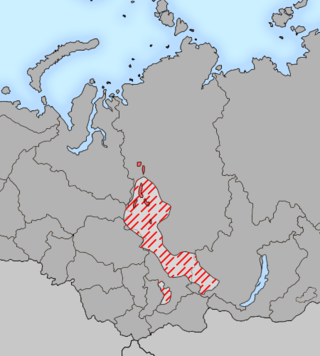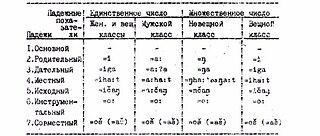Related Research Articles

The Yenisey, also romanised as Yenisei or Jenisej, is the fifth-longest river system in the world, and the largest to drain into the Arctic Ocean.
The Jié were members of a tribe of northern China in the fourth century. During the period of the Sixteen Kingdoms, they were regarded by the Han people as one of the Five Barbarians. Under Shi Le and his family, they established the Later Zhao dynasty which dominated northern China for most of its existence from 319 to 351. The Jie ceased to play a role in Chinese history after Ran Min's culling order and the wars that followed the collapse of Later Zhao, although historians believe that certain prominent figures from later periods may have been descendants of the Jie.
The Ket language, or more specifically Imbak and formerly known as Yenisei Ostyak, is a Siberian language long thought to be an isolate, the sole surviving language of a Yeniseian language family. It is spoken along the middle Yenisei basin by the Ket people.
The Paleo-Siberian languages are several language isolates and small language families spoken in parts of Siberia. They are not known to have any genetic relationship to each other; their only common link is that they are held to have antedated the more dominant languages, particularly Tungusic and latterly Turkic languages, that have largely displaced them. Even more recently, Turkic and especially Tungusic have been displaced in their turn by Russian.

The Enets are a Samoyedic ethnic group who live on the east bank, near the mouth, of the Yenisei River. Historically nomadic people, they now mainly inhabit the village of Potalovo in Krasnoyarsk Krai in western Siberia near the Arctic Circle. According to the 2010 Census, there are 227 Enets in Russia. In Ukraine, there were 26 Entsi in 2001, of whom 18 were capable of speaking the Enets language.

The Yeniseian languages are a family of languages that are spoken by the Yeniseian people in the Yenisei River region of central Siberia. As part of the proposed Dené–Yeniseian language family, the Yeniseian languages have been argued to be part of "the first demonstration of a genealogical link between Old World and New World language families that meets the standards of traditional comparative-historical linguistics". The only surviving language of the group today is Ket.

Kets are a Yeniseian-speaking people in Siberia. During the Russian Empire, they were known as Ostyaks, without differentiating them from several other Siberian people. Later, they became known as Yenisei Ostyaks because they lived in the middle and lower basin of the Yenisei River in the Krasnoyarsk Krai district of Russia. The modern Kets lived along the eastern middle stretch of the river before being assimilated politically into Russia between the 17th and 19th centuries. According to the 2010 census, there were 1,220 Kets in Russia. According to the 2021 census, this number had declined to 1,088.

Ostyak is a name formerly used to refer to several Indigenous peoples and languages in Siberia, Russia. Both the Khanty people and the Ket people were formerly called Ostyaks, whereas the Selkup people were referred to as Ostyak-Samoyed.
The Hunnic language, or Hunnish, was the language spoken by Huns in the Hunnic Empire, a heterogeneous, multi-ethnic tribal confederation which invaded Eastern and Central Europe, and ruled most of Pannonian Eastern Europe, during the 4th and 5th centuries CE. A variety of languages were spoken within the Hun Empire. A contemporary report by Priscus has that Hunnish was spoken alongside Gothic and the languages of other tribes subjugated by the Huns.
Yugh is a Yeniseian language, closely related to Ket, formerly spoken by the Yugh people, one of the southern groups along the Yenisei River in central Siberia. It was once regarded as a dialect of the Ket language, which was considered to be a language isolate, and was therefore called Sym Ket or Southern Ket; however, the Ket considered it to be a distinct language. By the early 1990s there were only two or three fluent speakers remaining, and the language was virtually extinct. The 2002 Census recorded 19 ethnic Yugh in all of Russia. In the 2010 census, only one ethnic Yugh was counted, while in the 2020 census, 7 ethnic Yugh were counted, 3 of them stating that they were speakers of Yugh.

Chanyu or Shanyu, short for Chengli Gutu Chanyu, was the title used by the supreme rulers of Inner Asian nomads for eight centuries until superseded by the title "Khagan" in 402 CE. The title was most famously used by the ruling Luandi clan of the Xiongnu during the Qin dynasty and Han dynasty. It was later also used infrequently by the Chinese as a reference to Tujue leaders.
The Dingling were an ancient people who appears in Chinese historiography in the context of the 1st century BCE.

The Kott (Kot) language is an extinct Yeniseian language that was formerly spoken in central Siberia by the banks of Mana River, a tributary of the Yenisei river. It became extinct in the 1850s. Kott was closely related to Ket, still spoken farther north along the Yenisei river. Assan, a close relative, is sometimes considered a dialect of Kott.

Pumpokol is one of the Yeniseian languages. It has been extinct since the 18th century. Along with Arin, it shares many features with the ancient Xiongnu and Jie languages, and according to Alexander Vovin, Edward Vajda, and Étienne de la Vaissière, is closely related to them.
Yugh people are a critically endangered Yeniseian people, an indigenous group who originally lived throughout central Siberia. The Yugh people live along the Yenisei River from Yeniseisk to the mouth of the Dupches River.
Dené–Yeniseian is a proposed language family consisting of the Yeniseian languages of central Siberia and the Na-Dené languages of northwestern North America.
Ostyak is a name formerly used to refer to several indigenous peoples in Siberia.
Proto-Yeniseian or Proto-Yeniseic is the unattested reconstructed proto-language from which all Yeniseian languages are thought to descend from. It is uncertain whether Proto-Yeniseian had a similar tone/pitch accent system as Ket. Many studies about Proto-Yeniseian phonology have been done, however there are still many things unclear about Proto-Yeniseian. The probable location of the Yeniseian homeland is proposed on the basis of geographic names and genetic studies, which suggests a homeland in Southern Siberia.

The Yeniseian people refers either to the modern or ancient Siberian populations speaking Yeniseian languages. Despite evidence pointing to the historical presence of Yeniseian populations throughout Central Siberia and Northern Mongolia, only the Ket and Yugh people survive today. The modern Yeniseians live along the eastern middle stretch of the Yenisei River in Northern Siberia. According to the 2021 census, there were 1,088 Kets and 7 Yugs in Russia.
Surgutikha is a rural locality in Turukhansky District of Krasnoyarsk Krai, Russia, located along the Surgutikha river.
References
- ↑ Georg, Stefan (2007). A Descriptive Grammar of Ket (Yenisei-Ostyak). Folkestone, Kent: Global Oriental. ISBN 978-1-901903-58-4.
